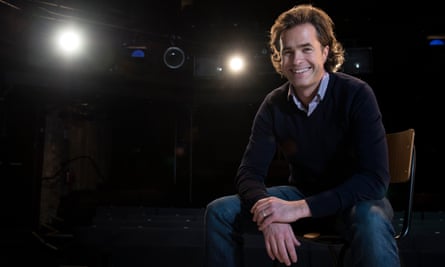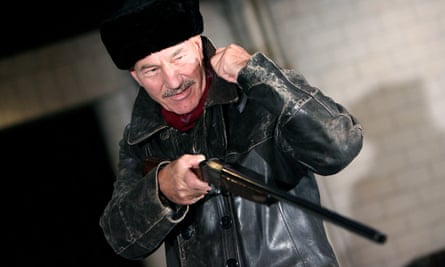I was in Stratford-upon-Avon in 2006, about to open The Tempest, with Patrick Stewart as Prospero. It was my debut in the main house and I was incredibly nervous. I came back to London and woke up in the morning feeling like death. I dragged myself off to hospital, and remember very clearly walking down this long corridor on the way to the appointment, convinced I had cancer. At the end was this beautiful doctor in an immaculate white coat, sitting calmly at a desk. I remember thinking: if I ever do Macbeth, this is what it’s going to look like.
Of course, I was fine. It was something minor. But when Patrick Stewart asked soon afterwards if I wanted to do Macbeth with him, I went back to that idea. I felt the play needed a very specific location. In Macbeth you have to accomplish a lot of groundwork very quickly: what’s the war, who’s fighting, what’s the political situation. The protagonist has a grand total of one line before he meets the Witches. I read Antonia Fraser’s book The Gunpowder Plot and started thinking hard about espionage, state tyranny, walls having ears. Initially the setting was going to be cold war, a bit John le Carré. But then it started going backwards in time. Patrick was in his late 60s by that point and we were conscious that he was quite old for the part, so we started thinking about the Soviet Union – all those old warriors lined up on parade. Then about Stalin. Patrick’s father was a soldier, and he came up with a character who was very obdurate, slow-thinking, stiff, granitic. I’d seen some quite fevered Macbeths, and this was utterly different. It seemed to fit.

The interesting thing with Shakespeare is that you can be quite broad in how you design something physically – obviously the theatres he was writing for had barely any scenery, and a huge amount is left to the imagination. But I’ve found it always helps if you and the actors have a strong idea of what the setting is. Somehow it anchors the action. We thought a lot about kitchens: blood and gore, of which there’s plenty in the play, but also the fact that a number of the scenes involve some kind of ceremony or entertainment – Duncan’s arrival, the feast for him, Macbeth’s coronation, the banquet scene where Banquo’s ghost appears. You have to imprint that the Macbeths have a marriage: they’re hosts, a real couple in a real space. Anthony Ward came up with a wonderful set: wipe-clean white tiles, lamps, a clattering lift upstage. Halfway between kitchen and morgue. I loved the lift in particular: it always seemed to be going down and down. The lift to hell. There was a bit of the movie Angel Heart there too, that sense of noir.
We never originally intended to cast my wife, Kate Fleetwood, as Lady M. Originally we had someone else in mind, but it didn’t work out quite late on. The casting director put Kate’s name on the list of actors we were going to audition, and I had to fess up that I was married to her. Patrick said, “Well, let’s see.” Then when she came in, it just worked. She’s a lot younger, but she has terrific attack and energy. I encouraged her to play that – not to over-psychologise the role, in a way. Some productions of the play get into trouble because both Macbeth and Lady M are working too hard. It’s too much, I think. So I encouraged her not to play the character, just the objective – just to do her job, which is to change him. But it was pretty intense, living with your Lady Macbeth. I’d be in bed, Kate would be cleaning her teeth, and I’d suddenly notice that she had books about Myra Hindley on the bedside table.

Actors are obsessed with the idea of the Macbeth curse, but on the first day of rehearsals I remember saying that we weren’t going to bother with any of that, it was luvvie rubbish. And this show was the opposite of cursed.
Everything just seemed to come together, first in Chichester, then the West End, then on Broadway. I got to see it change and develop over time; I learned a huge amount. It’s a theatre cliche that in comedies the company is at each other’s throats backstage, while in tragedies everyone gets on. But here that was definitely true. Macbeth was the luckiest show I’ve worked on.

Comments (…)
Sign in or create your Guardian account to join the discussion